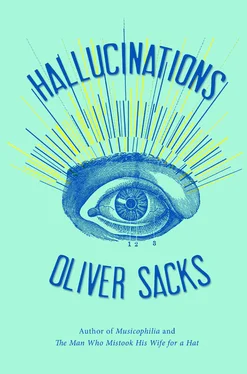This belief is a fairly recent one, as the careful and humane reservations of early researchers on schizophrenia made clear. But by the 1970s, antipsychotic drugs and tranquilizers had begun to replace other treatments, and careful history taking, looking at the whole life of the patient, had largely been replaced by the use of DSM criteria to make snap diagnoses.
Eugen Bleuler, who directed the huge Burghölzli asylum near Zurich from 1898 to 1927, paid close and sympathetic attention to the many hundreds of schizophrenic people under his care. He recognized that the “voices” his patients heard, however outlandish they might seem, were closely associated with their mental states and delusions. The voices, he wrote, embodied “all their strivings and fears … their entire transformed relationship to the external world … above all … [to] the pathological or hostile powers” that beset them. He described these in vivid detail in his great 1911 monograph, Dementia Praecox; or, The Group of Schizophrenias:
The voices not only speak to the patient, but they pass electricity through the body, beat him, paralyse him, take his thoughts away. They are often hypostasized as people, or in other very bizarre ways. For example, a patient claims that a “voice” is perched above each of his ears. One voice is a little larger than the other but both are about the size of a walnut, and they consist of nothing but a large ugly mouth.
Threats or curses form the main and most common content of the “voices.” Day and night they come from everywhere, from the walls, from above and below, from the cellar and the roof, from heaven and from hell, from near and far.… When the patient is eating, he hears a voice saying, “Each mouthful is stolen.” If he drops something, he hears, “If only your foot had been chopped off.”
The voices are often very contradictory. At one time they may be against the patient … then they may contradict themselves.… The roles of pro and con are often taken over by voices of different people.… The voice of a daughter tells a patient: “He is going to be burned alive,” while his mother’s voice says, “He will not be burned.” Besides their persecutors the patients often hear the voice of some protector.
The voices are often localized in the body.… A polyp may be the occasion for localizing the voices in the nose. An intestinal disturbance brings them into connection with the abdomen.… In cases of sexual complexes, the penis, the urine in the bladder, or the nose utter obscene words.… A really or imaginarily gravid patient will hear her child or children speaking inside her womb.…
Inanimate objects may speak. The lemonade speaks, the patient’s name is heard to be coming from a glass of milk. The furniture speaks to him.
Bleuler wrote, “Almost every schizophrenic who is hospitalized hears ‘voices.’ ” But he emphasized that the reverse did not hold — that hearing voices did not necessarily denote schizophrenia. In the popular imagination, though, hallucinatory voices are almost synonymous with schizophrenia — a great misconception, for most people who do hear voices are not schizophrenic.
Many people report hearing voices which are not particularly directed at them, as Nancy C. wrote:
I hallucinate conversations on a regular basis, often as I am falling asleep at night. It seems to me that these conversations are real and are actually taking place between real people, at the very time I’m hearing them, but are occurring somewhere else. I hear couples arguing, all kinds of things. They are not voices I can identify, they are not people I know. I feel like I’m a radio, tuned into someone else’s world. (Though always an American-English-speaking world.) I can’t think of any way to regard these experiences except as hallucinations. I am never a participant; I am never addressed. I am just listening in.
“Hallucinations in the sane” were well recognized in the nineteenth century, and with the rise of neurology, people sought to understand more clearly what caused them. In England in the 1880s, the Society for Psychical Research was founded to collect and investigate reports of apparitions or hallucinations, especially those of the bereaved, and many eminent scientists — physicists as well as physiologists and psychologists — joined the society (William James was active in the American branch). Telepathy, clairvoyance, communication with the dead, and the nature of a spirit world became the subjects of systematic investigation.
These early researchers found that hallucinations were not uncommon in the general population. Their 1894 “International Census of Waking Hallucinations in the Sane” examined the occurrence and nature of hallucinations experienced by normal people in normal circumstances (they took care to exclude anyone with obvious medical or psychiatric problems). Seventeen thousand people were sent a single question:
Have you ever, when believing yourself to be completely awake, had a vivid impression of seeing or being touched by a living being or inanimate object, or of hearing a voice, which impression, as far as you could discover, was not due to an external physical cause?
More than 10 percent responded in the affirmative, and of those, more than a third heard voices. As John Watkins noted in his book Hearing Voices , hallucinated voices “having some kind of religious or supernatural content represented a small but significant minority of these reports.” Most of the hallucinations, however, were of a more quotidian character.
Perhaps the commonest auditory hallucination is hearing one’s own name spoken — either by a familiar voice or an anonymous one. Freud, writing in The Psychopathology of Everyday Life , remarked on this:
During the days when I was living alone in a foreign city — I was a young man at the time — I quite often heard my name suddenly called by an unmistakable and beloved voice; I then noted down the exact moment of the hallucination and made anxious enquiries of those at home about what had happened at that time. Nothing had happened. 18 18 Freud was not unsympathetic to the notion of telepathy; his “Psychoanalysis and Telepathy” was written in 1921, though published only posthumously.
The voices that are sometimes heard by people with schizophrenia tend to be accusing, threatening, jeering, or persecuting. By contrast, the voices hallucinated by the “normal” are often quite unremarkable, as Daniel Smith brings out in his book Muses, Madmen, and Prophets: Hearing Voices and the Borders of Sanity . Smith’s own father and grandfather heard such voices, and they had very different reactions. His father started hearing voices at the age of thirteen, Smith writes:
These voices weren’t elaborate, and they weren’t disturbing in content. They issued simple commands. They instructed him, for instance, to move a glass from one side of the table to another or to use a particular subway turnstile. Yet in listening to them and obeying them his interior life became, by all reports, unendurable.
Smith’s grandfather, by contrast, was nonchalant, even playful, in regard to his hallucinatory voices. He described how he tried to use them in betting at the racetrack. (“It didn’t work, my mind was clouded with voices telling me that this horse could win or maybe this one is ready to win.”) It was much more successful when he played cards with his friends. Neither the grandfather nor the father had strong supernatural inclinations; nor did they have any significant mental illness. They just heard unremarkable voices concerned with everyday things — as do millions of others.
Smith’s father and grandfather rarely spoke of their voices. They listened to them in secrecy and silence, perhaps feeling that admitting to hearing voices would be seen as an indication of madness or at least serious psychiatric turmoil. Yet many recent studies confirm that it is not that uncommon to hear voices and that the majority of those who do are not schizophrenic; they are more like Smith’s father and grandfather. 19 19 Recently, a number of people who hear voices have organized networks in various countries asserting their “right” to hear voices, to have them respected and not dismissed as trivial or pathological. This movement and its significance are discussed by Ivan Leudar and Philip Thomas in their book Voices of Reason, Voices of Madness and by Sandra Escher and Marius Romme in their 2012 review of the subject.
Читать дальше












